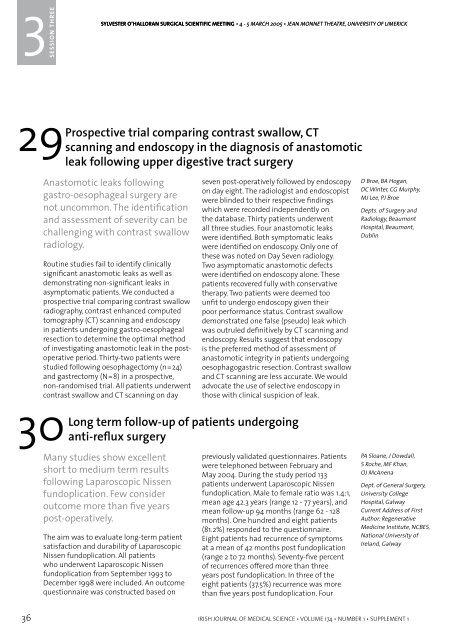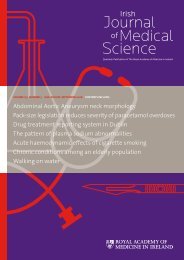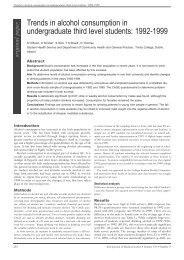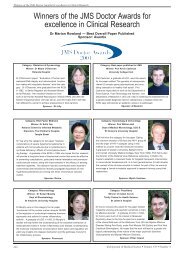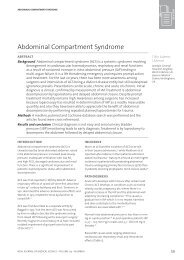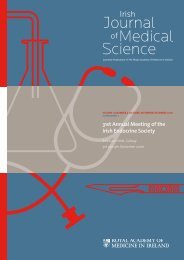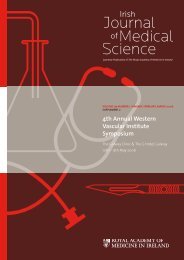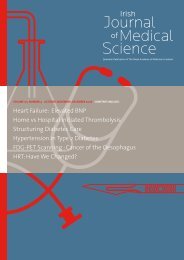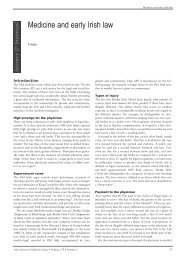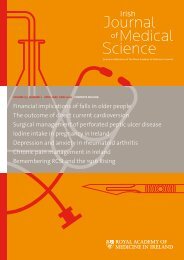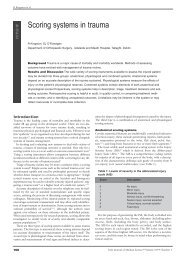Sylvester O'Halloran Surgical Scientific Meeting - IJMS | Irish Journal ...
Sylvester O'Halloran Surgical Scientific Meeting - IJMS | Irish Journal ...
Sylvester O'Halloran Surgical Scientific Meeting - IJMS | Irish Journal ...
You also want an ePaper? Increase the reach of your titles
YUMPU automatically turns print PDFs into web optimized ePapers that Google loves.
31<br />
1<br />
SESSION THREE ONE<br />
SYLVESTER O’HALLORAN SURGICAL SCIENTIFIC MEETING • 4 - 5 MARCH 2005 • JEAN MONNET THEATRE, UNIVERSITY OF LIMERICK<br />
SYLVESTER O’HALLORAN SURGICAL SCIENTIFIC MEETING • 4 - 5 MARCH 2005 • JEAN MONNET THEATRE, UNIVERSITY OF LIMERICK<br />
3<br />
SESSION<br />
SESSION THREE ONE<br />
29<br />
Prospective trial comparing contrast swallow, CT<br />
scanning and endoscopy in the diagnosis of anastomotic<br />
leak following upper digestive tract surgery<br />
30<br />
Anastomotic leaks following<br />
gastro-oesophageal surgery are<br />
not uncommon. The identification<br />
and assessment of severity can be<br />
challenging with contrast swallow<br />
radiology.<br />
Routine studies fail to identify clinically<br />
significant anastomotic leaks as well as<br />
demonstrating non-significant leaks in<br />
asymptomatic patients. We conducted a<br />
prospective trial comparing contrast swallow<br />
radiography, contrast enhanced computed<br />
tomography (CT) scanning and endoscopy<br />
in patients undergoing gastro-oesophageal<br />
resection to determine the optimal method<br />
of investigating anastomotic leak in the postoperative<br />
period. Thirty-two patients were<br />
studied following oesophagectomy (n=24)<br />
and gastrectomy (N=8) in a prospective,<br />
non-randomised trial. All patients underwent<br />
contrast swallow and CT scanning on day<br />
seven post-operatively followed by endoscopy<br />
on day eight. The radiologist and endoscopist<br />
were blinded to their respective findings<br />
which were recorded independently on<br />
the database. Thirty patients underwent<br />
all three studies. Four anastomotic leaks<br />
were identified. Both symptomatic leaks<br />
were identified on endoscopy. Only one of<br />
these was noted on Day Seven radiology.<br />
Two asymptomatic anastomotic defects<br />
were identified on endoscopy alone. These<br />
patients recovered fully with conservative<br />
therapy. Two patients were deemed too<br />
unfit to undergo endoscopy given their<br />
poor performance status. Contrast swallow<br />
demonstrated one false (pseudo) leak which<br />
was outruled definitively by CT scanning and<br />
endoscopy. Results suggest that endoscopy<br />
is the preferred method of assessment of<br />
anastomotic integrity in patients undergoing<br />
oesophagogastric resection. Contrast swallow<br />
and CT scanning are less accurate. We would<br />
advocate the use of selective endoscopy in<br />
those with clinical suspicion of leak.<br />
Long term follow-up of patients undergoing<br />
anti-reflux surgery<br />
Many studies show excellent<br />
short to medium term results<br />
following Laparoscopic Nissen<br />
fundoplication. Few consider<br />
outcome more than five years<br />
post-operatively.<br />
The aim was to evaluate long-term patient<br />
satisfaction and durability of Laparoscopic<br />
Nissen fundoplication. All patients<br />
who underwent Laparoscopic Nissen<br />
fundoplication from September 1993 to<br />
December 1998 were included. An outcome<br />
questionnaire was constructed based on<br />
previously validated questionnaires. Patients<br />
were telephoned between February and<br />
May 2004. During the study period 133<br />
patients underwent Laparoscopic Nissen<br />
fundoplication. Male to female ratio was 1.4:1,<br />
mean age 42.3 years (range 12 - 77 years), and<br />
mean follow-up 94 months (range 62 - 128<br />
months). One hundred and eight patients<br />
(81.2%) responded to the questionnaire.<br />
Eight patients had recurrence of symptoms<br />
at a mean of 42 months post fundoplication<br />
(range 2 to 72 months). Seventy-five percent<br />
of recurrences offered more than three<br />
years post fundoplication. In three of the<br />
eight patients (37.5%) recurrence was more<br />
than five years post fundoplication. Four<br />
D Broe, BA Hogan,<br />
DC Winter, CG Murphy,<br />
MJ Lee, PJ Broe<br />
Depts. of Surgery and<br />
Radiology, Beaumont<br />
Hospital, Beaumont,<br />
Dublin<br />
PA Sloane, J Dowdall,<br />
S Roche, MF Khan,<br />
OJ McAnena<br />
Dept. of General Surgery,<br />
University College<br />
Hospital, Galway<br />
Current Address of First<br />
Author: Regenerative<br />
Medicine Institute, NCBES,<br />
National University of<br />
Ireland, Galway<br />
31<br />
underwent refundoplication at a mean of<br />
54.25 months after original surgery (range 12<br />
to 86 months). Outcome was rated as cure<br />
or excellent by 101 patients (93.5%), including<br />
all four patients who had refundoplication.<br />
Seven patients (6.5%) rated outcome as<br />
failure, four because of symptom recurrence<br />
and three because of wrap take down.<br />
Laparoscopic Nissen fundoplication results<br />
in a high degree of patient satisfaction.<br />
A significant proportion of symptom<br />
recurrences occur late. Short to medium<br />
term follow-up studies do not identify these<br />
patients. This needs to be considered when<br />
evaluating their outcome.<br />
Boerhaave’s syndrome: fourteen cases of spontaneous<br />
oesophageal rupture with varying management<br />
strategies in a single centre<br />
Spontaneous oesophageal rupture,<br />
also known as Boerhaave’s<br />
syndrome, is rare and carries a high<br />
associated morbidity and mortality.<br />
Individual surgical experience<br />
with this condition remains low<br />
and therefore the management of<br />
Boerhaave’s remains controversial.<br />
Methods<br />
A retrospective review of cases presenting<br />
to St. James’s hospital, as a tertiary referral<br />
centre, over a period of eight years was<br />
reviewed. Perforations were excluded if<br />
iatrogenic or secondary to underlying<br />
oesophageal disease.<br />
Results<br />
A total of fourteen patients were identified.<br />
There were eleven men and three women,<br />
whose ages ranged from 39 to 75 years.<br />
Eight patients were managed operatively<br />
while six were managed conservatively.<br />
Diagnosis was based on clinical history<br />
and examination, oesophageal contrast<br />
swallow and CT scanning. Seven patients<br />
underwent thoracotomy with primary closure<br />
of the oesophageal perforation and tissue<br />
reinforcement. One patient underwent<br />
oesophagogastrectomy. Mean post-operative<br />
stay was 39 days with a mean ICU stay of 7.5<br />
days. A covered stent was placed at OGD in<br />
two patients who were treated conservatively.<br />
Mean in-patient stay for those managed nonoperatively<br />
was 61 days with 18.2 days in ICU.<br />
Mortality was identical in both groups (n=1).<br />
Morbidity was slightly higher in the group<br />
treated conservatively (n=4/6) compared to<br />
surgical intervention (n=5/8)<br />
Conclusions<br />
<strong>Surgical</strong> intervention remains the gold<br />
standard for cases which are diagnosed<br />
promptly. Where the diagnosis is delayed<br />
utilization of covered oesophageal stents<br />
is a viable option. In single institutions,<br />
management strategies can be customised,<br />
thus reducing overall mortality.<br />
RS Prichard, J Butt,<br />
N Al-Sarraf, S Frolich,<br />
B Manning, N Ravi,<br />
JV Reynolds<br />
Upper Gastrointestinal<br />
<strong>Surgical</strong> Professorial<br />
Unit, St. James’s Hospital,<br />
James’s Street, Dublin<br />
32 Pulmonary emboli in the surgical community R FitzGerald, S Rajendran,<br />
Despite significant advances in the<br />
prevention and treatment of venous<br />
thromboembolism, pulmonary embolism<br />
remains the most common<br />
preventable cause of hospital death.<br />
It is imperative, thus, to identify at risk-patient<br />
groups who would benefit from higher dose<br />
thromboprophylaxis in an attempt to decrease<br />
morbidity and mortality from this condition.<br />
We performed a retrospective study of<br />
all patients admitted to Wexford General<br />
C Canning, Z Martin,<br />
D Beddy, JB O’Mahony,<br />
K Mealy, D Evoy<br />
Dept. of Surgery, Wexford<br />
General Hospital, Wexford<br />
36 IRISH JOURNAL OF MEDICAL SCIENCE • VOLUME 174 • NUMBER 1 • SUPPLEMENT 1<br />
IRISH JOURNAL OF MEDICAL SCIENCE • VOLUME 174 • NUMBER 1 • SUPPLEMENT 1 37


